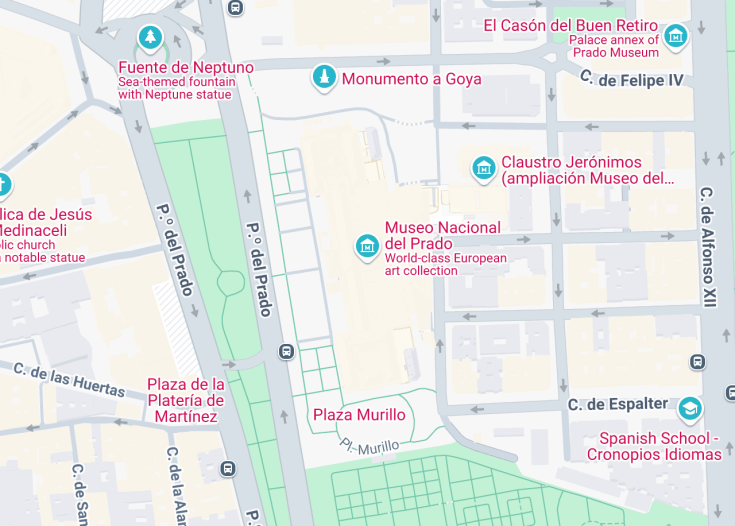Located in the heart of Madrid, the Museo del Prado is one of the most prestigious art galleries in the world. Established in 1819, the museum boasts a vast collection of over 7,000 paintings, focusing on masterpieces from Spanish artists like Velázquez and Goya. The Prado also offers a significant selection of European art, making it a fundamental destination for art enthusiasts. The museum’s regal architecture and the historical ambiance enhance the viewer’s experience, encapsulating Spain’s rich cultural heritage.
To make the most of your visit, consider joining a guided tour. Exploring the museum with an expert can offer profound insights into the artwork’s background and significance.
Due to the vast size of the collection, it’s advisable to prioritize seeing the highlights like “Las Meninas” or the “Black Paintings.” This approach helps to manage time more effectively during the visit.
A treasure trove of masterpieces
The Museo del Prado in Spain is not just a museum; it is an emblem of art and culture. Located in the heart of Madrid, it is one of the most visited and revered art galleries in the world. It houses an extensive collection of European art, from the 12th century to the early 20th century, featuring more than 8,600 paintings and over 700 sculptures. The Prado’s collection includes works by masters such as Velázquez, Goya, and Titian. For art enthusiasts and tourists alike, the museum offers an immersive journey into the history of Western art. With its rich historical significance and breathtaking exhibits, the Museo del Prado is a must-visit destination that captivates the spirit and enriches the mind.
Exploring artistic gems
Visitors to the Museo del Prado will find themselves enthralled in a world of renowned artworks and captivating exhibitions. Highlights include the Royal Collection exemplifying the depictions of classical mythology alongside important religious works. Don’t miss the famed “Las Meninas” by Velázquez and Goya’s “The Third of May 1808,” which convey deep historical and cultural narratives. The museum also offers temporary exhibitions, educational programs, and guided tours that enhance the understanding of its esteemed collections.
Guardians of history
The Garden of Earthly Delights by Hieronymus Bosch is an essential masterpiece found at the Museo del Prado. This triptych is renowned for its intricate detail and fascinating, often puzzling imagery depicting paradise, earth, and hell. Its allegorical and provocative scenes invite viewers to interpret the philosophical meanings behind them. Additionally, it serves as a significant work for scholars studying the Northern Renaissance and the evolution of pictorial art.
Explore the wonders of Museo Del Prado
Perfect for art enthusiasts of all ages, the Museo Del Prado offers a deep dive into the world of classical art with its rich collections from the Spanish, Italian, and Flemish schools. Whether you are an avid art connoisseur, a couple looking to soak in the cultural environment, or even older individuals interested in historical artworks, Museo Del Prado caters to all. Visitors can expect to see masterpieces by renowned artists such as Velázquez, Goya, and Titian, making it a treasure trove of historical and artistic wealth.
Discover the ideal time to visit Museo Del Prado
The best times to visit Museo Del Prado are during the quieter morning hours on weekdays or later in the afternoon after the rush of group tours. To fully enjoy the museum’s offerings without the crowds, planning an off-peak visit can greatly enhance the experience.
Annual must-see events
For those looking for a unique experience, attend the annual “Prado Day” event. It celebrates the museum’s rich history and offers special tours and exhibits, making it a perfect time for an enriched cultural visit.
Accessibility and limitations at Museo Del Prado
Accessibility
Limitations
- Flash photography is prohibited
- Large bags must be checked in at the cloakroom
- No food or beverages in the exhibit areas
Notes to visitors
- Wearing comfortable shoes is recommended due to the extensive walking
- The museum can be crowded; patience is appreciated
- Guided tours are available in multiple languages for non-Spanish speakers
General information
Location
Located conveniently near major historical sites in Madrid, Museo Del Prado is easily accessible from the city center. Nearby landmarks include Retiro Park and Plaza Mayor, offering an enriching cultural itinerary for visitors.
Address: Paseo del Prado, s/n, 28014 Madrid, Spain
Opening hours
Museo Del Prado is open from 10 AM to 8 PM on weekdays and 10 AM to 7 PM on Sundays. The museum is closed on January 1, May 1, and December 25.
How to reach Museo Del Prado
Car
Visitors can drive to Museo Del Prado, with several parking options available in the vicinity. Here’s how you can reach by car:
| Route | Distance | Travel time |
|---|---|---|
| From Madrid Airport | 15 miles (24 Km) | 25 minutes |
| From Sol | 2 miles (3.2 Km) | 10 minutes |
Public Transport
Utilizing Madrid’s extensive public transportation network is an efficient way to reach Museo Del Prado. Metro and bus services connect directly to stops near the museum, ensuring accessibility from all parts of the city.
Nearby Attractions
Enhance your visit by exploring these nearby attractions:
- Retiro Park – 0.3 miles (0.5 km)
- Thyssen-Bornemisza Museum – 0.2 miles (0.3 km)
- Reina Sofia Museum – 0.7 miles (1.1 km)
Common questions
What are the must-see artworks at the Museo Del Prado?
- “Las Meninas” by Diego Velázquez – This painting is not only a masterpiece of Spanish art but also a complex study of real and reflected space, offering a unique view into the life of the Spanish court.
- “The Garden of Earthly Delights” by Hieronymus Bosch – This triptych is famous for its detailed and imaginative depiction of fantastical figures and landscapes.
- “The Third of May 1808” by Francisco Goya – This painting is an emotional response to the Spanish resistance against Napoleon’s armies and is hailed for its dramatic portrayal and historical importance.
- “The Annunciation” by Fra Angelico – A fine example of early Renaissance art, noted for its serene and harmonious depiction of the biblical scene.
These artworks are cornerstones of the Prado’s collection and are pivotal in the history of art.
What is the architectural style of the Museo Del Prado?
Can you share some history about the Museo Del Prado?
Is photography allowed inside the Museo Del Prado?
Are there guided tours available at the Museo Del Prado?
What accessibility services does the Museo Del Prado provide?
- Physical Accessibility: Ramps, elevators, and accessible restrooms are available throughout the museum.
- Visual Resources: Tactile tours and adapted guided tours are available for visitors who are blind or have low vision.
- Auditory Resources: Subtitles and sign language guides are available for hearing-impaired visitors.
- Specialized Tours: These tours are designed for visitors with cognitive disabilities and aim to offer an engaging and comprehensible museum experience.
The museum also allows service animals and offers wheelchairs on a first-come, first-served basis.
Does the Museo Del Prado have a restaurant or café?
How can I locate a specific artwork in the Museo Del Prado?
- Official Museum Map: Available at the entrance and information desks, the map provides the layout of the galleries and the location of major artworks.
- Mobile App: The Prado’s official mobile app includes an interactive map and additional content about the artworks, making it easier to navigate the museum and learn more about its collections.
- Information Desks: Staff members at information desks are knowledgeable and can provide directions and information about the location of specific pieces.
Preparation is key. Reviewing the museum’s layout and the collections beforehand can help in quickly locating desired artworks.
Are there lockers available at the Museo Del Prado?
Can I bring a stroller into the Museo Del Prado?
What educational programs are available at the Museo Del Prado?
- Workshops: These are typically hands-on sessions that aim to engage participants in practical art-making related to the museum’s collections.
- Lectures and Seminars: Regular talks are given by art historians and specialists on various themes related to the museum’s artworks and exhibitions.
- School Programs: Tailored educational initiatives designed for students of all ages to enhance their understanding and appreciation of art.
- Cultural Events: Concerts, readings, and other cultural activities that often tie in with the museum’s art collections or special exhibitions.
These programs are designed to deepen public engagement with art and foster an appreciation for art history.
Is there a gift shop in the Museo Del Prado?

Is the Museo Del Prado in Madrid worth a visit?
The Museo Del Prado in Madrid stands out as a premier destination for art enthusiasts worldwide, boasting an extensive collection of European art from the 12th century to the early 20th century. Highlights include masterpieces by Velázquez, Goya, and Rubens. However, due to its vast size and the rich density of its collections, some visitors may find it somewhat overwhelming. It is advisable for tourists to plan their visit ahead, possibly focusing on specific sections or artworks of interest to maximize their experience. Moreover, for those deeply interested in art and history, the Prado is undeniably worthwhile, offering deep dives into Spanish and European art history that are rarely matched by other institutions.










